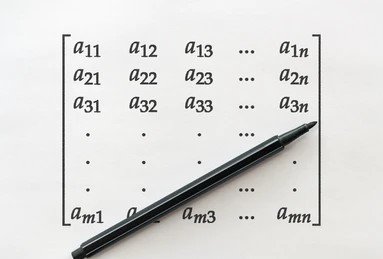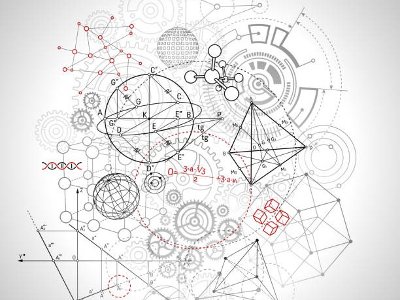Matrices, Determinants, and Systems of Linear Equations - Linear Algebra (Undergraduate Advanced)
57
26 hrs
 MTH 202: Mathematical Methods IIComprehensive treatise of advanced mathematics covering vector calculus, complex numbers, linear vector spaces, linear maps, matrices, eigenvalues and eigenvectors.
Curated for second-year students of engineering and physical sciences at Obafemi Awolowo University, Ile-Ife, Nigeria. Students and professionals with similar learning goal will also find this learning track useful.
MTH 202: Mathematical Methods IIComprehensive treatise of advanced mathematics covering vector calculus, complex numbers, linear vector spaces, linear maps, matrices, eigenvalues and eigenvectors.
Curated for second-year students of engineering and physical sciences at Obafemi Awolowo University, Ile-Ife, Nigeria. Students and professionals with similar learning goal will also find this learning track useful.
Comprehensive treatise of advanced mathematics covering vector calculus, complex numbers, linear vector spaces, linear maps, matrices, eigenvalues and eigenvectors. Curated for second-year students of engineering and physical sciences at Obafemi Awolowo University, Ile-Ife, Nigeria. Students and professionals with similar learning goal will also find this learning track useful.
 CHE 305: Engineering Analysis IAdvanced engineering mathematics covering solid analytical geometry, integrals, scalar and vector fields, matrices and determinants and complex variables.
Curated for third-year students of engineering at Obafemi Awolowo University, Ile-Ife, Nigeria. Students and professionals with similar learning goal will also find this learning track useful.
CHE 305: Engineering Analysis IAdvanced engineering mathematics covering solid analytical geometry, integrals, scalar and vector fields, matrices and determinants and complex variables.
Curated for third-year students of engineering at Obafemi Awolowo University, Ile-Ife, Nigeria. Students and professionals with similar learning goal will also find this learning track useful.
Advanced engineering mathematics covering solid analytical geometry, integrals, scalar and vector fields, matrices and determinants and complex variables. Curated for third-year students of engineering at Obafemi Awolowo University, Ile-Ife, Nigeria. Students and professionals with similar learning goal will also find this learning track useful.
 GET 209: Engineering Mathematics IMaster the mathematical language of engineering. This programme delivers the complete analytical toolkit required for a successful engineering career, covering single-variable calculus, multivariable calculus, linear algebra, and vector analysis. It provides the essential foundation for all subsequent engineering courses.
This programme is for second-year undergraduate students across all engineering disciplines. It delivers the official NUC CCMAS curriculum for Engineering Mathematics, providing the core training required for advanced modules in mechanics, thermodynamics, and circuit theory.
Model and analyse complex physical systems using calculus, linear algebra, and vector analysis. You will be equipped to solve problems in dynamics, statics, and field theory, providing the quantitative proficiency required for advanced engineering study and professional practice.
GET 209: Engineering Mathematics IMaster the mathematical language of engineering. This programme delivers the complete analytical toolkit required for a successful engineering career, covering single-variable calculus, multivariable calculus, linear algebra, and vector analysis. It provides the essential foundation for all subsequent engineering courses.
This programme is for second-year undergraduate students across all engineering disciplines. It delivers the official NUC CCMAS curriculum for Engineering Mathematics, providing the core training required for advanced modules in mechanics, thermodynamics, and circuit theory.
Model and analyse complex physical systems using calculus, linear algebra, and vector analysis. You will be equipped to solve problems in dynamics, statics, and field theory, providing the quantitative proficiency required for advanced engineering study and professional practice.
Master the mathematical language of engineering. This programme delivers the complete analytical toolkit required for a successful engineering career, covering single-variable calculus, multivariable calculus, linear algebra, and vector analysis. It provides the essential foundation for all subsequent engineering courses. This programme is for second-year undergraduate students across all engineering disciplines. It delivers the official NUC CCMAS curriculum for Engineering Mathematics, providing the core training required for advanced modules in mechanics, thermodynamics, and circuit theory. Model and analyse complex physical systems using calculus, linear algebra, and vector analysis. You will be equipped to solve problems in dynamics, statics, and field theory, providing the quantitative proficiency required for advanced engineering study and professional practice.
Course Chapters
1. Introduction6
Meaning of matrices, types of matrices, and other descriptive terminologies.
Chapter lessons
1-5. Some special matrices (3)20:56
2. Algebra of Matrices72
Addition of matrices, multiplication of matrices by scalars, multiplication of matrices by matrices, etc.
Chapter lessons
2-3. Properties of matrix addition6:53
2-5. Properties of scalar multiplication7:22
2-7. Properties of matrix multiplication10:51
3. Transposition of Matrices72
Transposition of matrices and properties of matrix transposes.
Chapter lessons
3-4. Conjugates and conjugate transposes11:36
3-7. Properties of the transpose18:49
Properties of matrix transposes.
4. Elementary Transformations112
Elementary row and column operations on matrices; row echelon and reduced row echelon forms; rank and nullity of matrices.
Chapter lessons
4-1. Introduction27:40
Meaning of elementary transformations - elementary row and column operations.
4-2. Equivalent matrices5:45
Meaning of equivalence, row equivalence and column equivalence of matrices.
4-3. Elementary matrices16:52
Meaning, notations and examples of elementary matrices.
4-4. Theorems (1)23:50
Some theorems on elementary transformations - row and column operations.
4-5. Theorems (2)24:33
Some theorems on elementary matrices.
4-6. Theorems (3)8:41
Some theorems on equivalent matrices.
4-7. Row echelon form (1)13:38
Meaning of a row echelon form of a matrix.
4-8. Row echelon form (2)23:06
Reduction of a matrix to a row echelon form.
4-9. Reduced row echelon form (1)10:56
Meaning of the reduced row echelon form of a matrix.
4-10. Reduced row echelon form (2)27:58
Reduction of a matrix to its reduced row echelon form.
4-11. Rank and nullity of a matrix4:58
Meaning of rank and nullity of a matrix.
5. Determinants94
Meaning, operations and properties of determinants.
Chapter lessons
5-1. Introduction6:41
Meaning and notations of determinants, singular and non-singular matrices.
5-2. Determinants of orders 1 and 26:12
Computing determinants of orders 1 and 2.
5-3. Signs, minors and cofactors18:41
Meaning of sign factor, minor and cofactor of an element in a matrix.
5-4. Determinants of any order34:27
Formal definition (Laplace expansion formula) of determinants, and how to evaluate determinants of any order.
5-5. Properties of determinants (1)11:30
Determinants of matrix transposes and products, similar matrices, etc.
5-6. Properties of determinants (2)9:06
Properties of determinants involving zero or identical rows (or columns), triangular and diagonal matrices.
5-7. Properties of determinants (3)23:50
Properties of determinants involving elementary row (or column) operations.
5-8. Properties of determinants (4)12:50
Properties of determinants involving sums, derivatives and integrals.
5-9. Cramer's rule19:13
How to solve a square system of linear equations using determinants - Cramer's rule.
6. Matrix Inverses92
Meaning, operations and properties of matrix inverses.
Chapter lessons
6-1. Adjoints8:01
Definition of the adjoint of a matrix.
6-2. Properties of adjoints9:22
Properties of the adjoint of a matrix and their applications.
6-3. Matrix inverse18:01
Definition of the inverse element and the inverse of a matrix.
6-4. Properties of matrix inverses (1)14:16
Properties of matrix inverses and their applications - uniqueness, inverses of products, transposes and scalar multiples.
6-5. Properties of matrix inverses (2)26:28
Properties of matrix inverses and their applications - elementary row operations on an invertible matrix to give the identity matrix.
6-6. Properties of matrix inverses (3)27:41
Properties of matrix inverses and their applications - solutions of square systems of linear equations.
6-7. Properties of matrix inverses (4)7:53
Properties of matrix inverses and their applications - implications on rank, determinant, homogeneous square systems of linear equations, etc.
6-8. More special matrices7:12
Orthogonal, singular, non-singular, invertible and non-invertible matrices.
6-9. Similar matrices19:16
When are two matrices said to be similar?
7. Systems of Linear Equations72
Application of matrices, determinants and inverses in solving systems of linear equations, consistency of systems of linear equations and applicable theorems.
Chapter lessons
7-1. Definition28:07
Meaning, matrix representation and homogeneity of systems of linear equations
7-2. Solutions15:48
Meaning and kinds of solutions of systems of linear equations; meaning of consistency of systems of linear equations.
7-3. Equivalent systems42:00
When are two systems of linear equations equivalent? What is the impact of elementary row operations on the systems of equations?
7-4. Consistency28:20
How to detect inconsistency in systems of linear equations using elementary row operations - how the ranks of coefficient and augmented matrices tell inconsistency.
7-5. Nonhomogeneous systems20:00
Conditions for existence of different forms of solutions for nonhomogeneous systems of linear equations.
7-6. Homogeneous systems6:07
Conditions for existence of different forms of solutions for homogeneous systems of linear equations.
7-7. Pivots and free variables27:36
How to determine what variables to parameterize in reporting infinitely many solutions for linear systems of equations.
8. Computer-Aided Handling11
Manipulating matrices with Microsoft Excel (Google Sheets) software.
Chapter lessons
8-1. MS-Excel (Google Sheets)13:50
Manipulating matrices with MS-Excel (Google Sheets) - algebra, transposes, determinants and inverse of matrices.